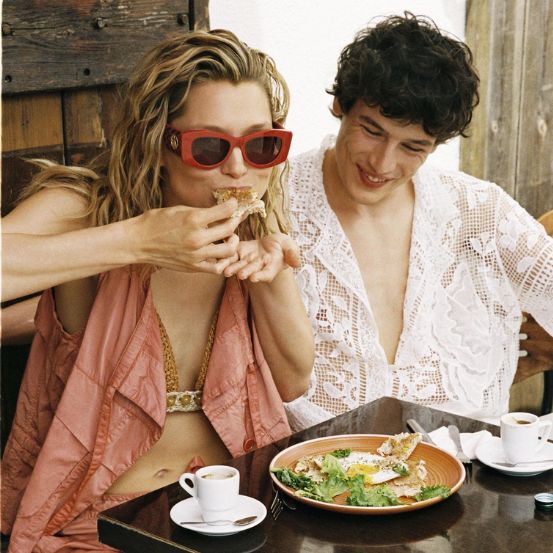The Passion Issue
Can my passion for you burn while my self-love helms?
In Greek mythology, Eros, the god of passion and desire, ruled over the carnal pull that ignites when we yearn for another. Often depicted alongside his mother, Aphrodite, Eros was her perfect counterpart—lust to her love, passion to her emotion. Together, they painted a portrait of love and passion as kindred forces, inseparable and intertwined.
But in modern times, the narrative has shifted. Love is no longer solely about union; it has become a reflection of self. Self-love reigns supreme, its mantra woven into the fabric of our relationships. "I am center," it declares, "and my love for myself must lead." Yet, in this neo-pantheon of love, where self is sovereign, how do we make room for passion? How do we nurture the fire of connection without letting it consume the self—or extinguish the bond?
Are we redefining love for a new era, or are we slowly losing its essence?
Alas, to answer this question, perhaps we must return to the original pantheon. Mythology tells us that Eros, complete as he seemed in his dominion over passion, was lonely. Passion, it turns out, can exist in isolation—but it cannot thrive there. So Aphrodite, ever the wise orchestrator of love, gifted him a companion: his brother, Anteros.
The god of requited love, Anteros was Eros’ perfect counterpart. Where passion burned wildly, reciprocity grounded it. The lesson was clear—love, to truly prosper, must be answered. It is not enough to feel; one must also be felt. Anteros’ presence balanced the fervor of Eros, teaching that love, while divine in its passion, reaches its highest form when it is mutual.
Eros and Anteros, often portrayed balancing the scales of love, were central figures among the Erotes—Aphrodite’s court of love gods, each embodying a unique facet of the divine emotion: desire, longing, sweet-talk, and more. Within their dynamic lies the answer to an age-old question: can passion burn fiercely while love, in its many forms, helms the soul?
Now, because not all answers can rest in tales and mythology, one must turn to modern science for insight. What do psychology and medicine have to say about this age-old question? In a rather unorthodox turn of events, the expert of choice happens to be someone who taught me my first lessons in love—my mother.
Dr. Ruth Villanueva, a psychopedagogue specializing in family relationships, has spent her career exploring the delicate interplay between self-love, connection, and passion. Her perspective bridges the emotional and the empirical, offering clarity in an era where love is often redefined.
“Love is a feeling that also requires expression, both toward oneself and others,” she says. “When love is not expressed, it is incomplete.” This duality—of loving oneself while giving to others—lies at the heart of her philosophy. It challenges the modern inclination to place the self above all else.
On the balance between giving and receiving, she notes, “A person who only gives or only receives creates emotional imbalance both within themselves and in their relationships. Trust is necessary, as well as a willingness to give without quantitative or qualitative expectations.” This principle resonates deeply in today’s cultural context, where self-prioritization can sometimes tip into defensiveness, eroding the foundations of connection.
Dr. Villanueva emphasizes that passion, too, requires this balance. “The kind of passion that truly satisfies is the one built over time. Immediate gratification, like in casual relationships or fleeting encounters, does not reflect a real relationship. Passion is the final result of mutual construction, an investment made without individual expectations.”
Her insights into human nature anchor her perspective. “We are inherently social beings; we need relationships with others to grow, to feel good, and even to survive. From the moment we are born, we rely on others to care for us, protect us emotionally, and help us develop.” This dependence is not a weakness but rather a fundamental aspect of our existence.
Even the COVID-19 pandemic, with its enforced isolation, underscored this truth. “The isolation protected us physically but made us sick mentally. Today, mental health is one of the top priorities addressed by healthcare systems,” she explains, reinforcing that connection is not a luxury but a necessity.
For those navigating modern relationships, her advice is straightforward yet profound: “Self-love is the foundation for any healthy relationship; it allows me to enter from a place of stability, rather than from a need to fill emotional voids.” Yet she warns, “You cannot give what you do not have. If I lack self-love, I will seek that love in someone else, which creates imbalance.”
This duality—of self-love and connection—seems to echo the dance of Eros and Anteros: passion balanced by reciprocity, self-anchored yet shared. In today’s landscape, love and passion must be redefined, not as opposites but as forces that coexist when nurtured with care, patience, and trust.
Modern self-love champions boundaries, independence, and emotional resilience—qualities designed to protect us from losing ourselves in relationships. We are taught to prioritize our needs, advocate for our worth, and never compromise our peace. Yet passion often demands the opposite: a surrender to uncertainty, an unraveling of carefully constructed defenses.
This is where the tension lies. Vulnerability, the lifeblood of passion, can feel like a betrayal of the self-love we work so hard to cultivate. To expose our innermost selves, to risk rejection or heartache, goes against the narrative of self-preservation that has become so central to our lives.
But as Dr. Villanueva reminds us, “A relationship cannot be built from a defensive stance, constantly measuring how much we give or receive. Trust is necessary, as well as a willingness to give without quantitative or qualitative expectations.” True self-love does not exclude vulnerability—it enables it. When we are secure in our own worth, we can risk the kind of openness that passion demands.
Vulnerability, then, is not weakness. It is a testament to strength—the strength to trust, to connect, to let go without losing oneself. And in this delicate balance lies the possibility of a love that is both fierce and grounded, where passion and self-worth coexist.
The rise of self-love is a powerful corrective to generations of self-sacrifice. Today, love is increasingly framed as a conscious choice—a decision made from strength, not dependence. But as we prioritize the self, what becomes of passion? In its rawest form, passion thrives on abandon, on the dissolution of the self into the other. This modern ethos of self-prioritization, while empowering, can sometimes feel at odds with the wild, unguarded surrender that passion requires.
Have we traded passion for safety? Have we drawn boundaries so firm that we leave no room for the messiness of love? Or are we, in fact, evolving love into something deeper—something that doesn’t demand sacrifice but honors mutual growth?
Perhaps, as Anteros teaches us, the answer lies in reciprocity. Love in this era must find balance: the self and the other, autonomy and connection, passion and preservation. It is not a choice between these forces but a blending of them, an interplay that reflects the complexity of love itself.
Passion and self-love are often framed as opposites—one demanding surrender, the other insisting on autonomy. But true passion, the kind that transforms and endures, is not about losing oneself. It is about discovering new dimensions of the self through connection with another.
“Passion is the final result of mutual construction, an investment made without individual expectations,” Dr. Villanueva explains. This kind of passion is not instant; it is cultivated over time, built on trust, vulnerability, and shared intention.
When love begins from a place of self-assurance, it frees us to connect without fear of losing ourselves. Passion, then, becomes less about consuming or being consumed and more about illuminating one another—sharing in each other’s fullness rather than filling emotional voids.
However, this coexistence requires effort. It demands we approach relationships with courage, not caution; with openness, not guardedness. Self-love provides the anchor, but passion—wild, unpredictable, and deeply human—propels us forward.
In a world where self-love reigns supreme, love itself must evolve. It is not a question of choosing between self-prioritization and passion but of weaving the two into a single thread. Love in the modern era is a dance—a careful balance of boundaries and abandon, independence and intimacy.
But love, in all its forms, resists simplicity. Passion still demands risk, and connection still requires vulnerability. To love deeply, even in the age of self, is to step willingly into the unknown—not to lose ourselves but to expand ourselves.
Perhaps the greatest act of self-love is not self-preservation but the courage to let another light a fire within us, knowing it may burn but trusting it will also illuminate. Passion and self-love are not enemies; they are partners, each sharpening the other’s edges, each daring us to live more fully.
So, as we navigate this neo-pantheon of love—where the self stands tall but connection beckons—we must remember: love’s essence is not a choice to be made but a paradox to be embraced. In its complexity lies its beauty, and in its risk lies its reward.
Translated from the original in The Passion Issue, published February 2025. For full story and credits, see the print issue.
Relacionados

.png)
Da MAC para o Mundo: tudo o que importa saber sobre as tendências de maquilhagem atuais
09 Apr 2025
.jpg)
.jpg)





.jpg)